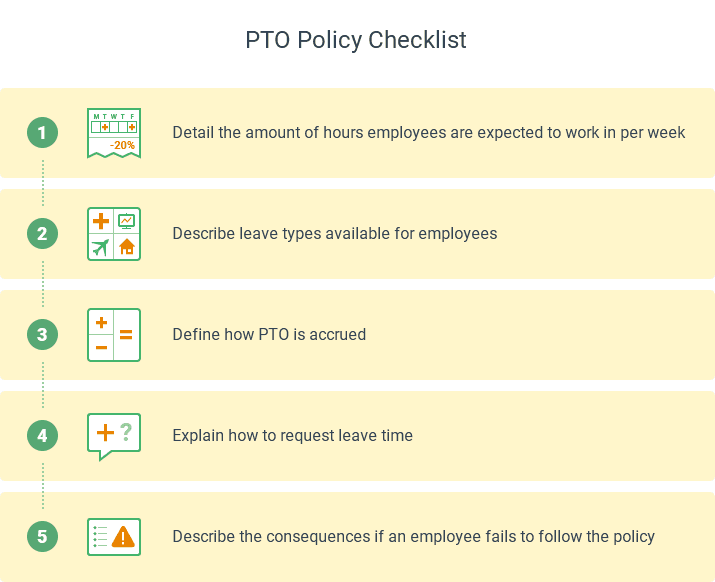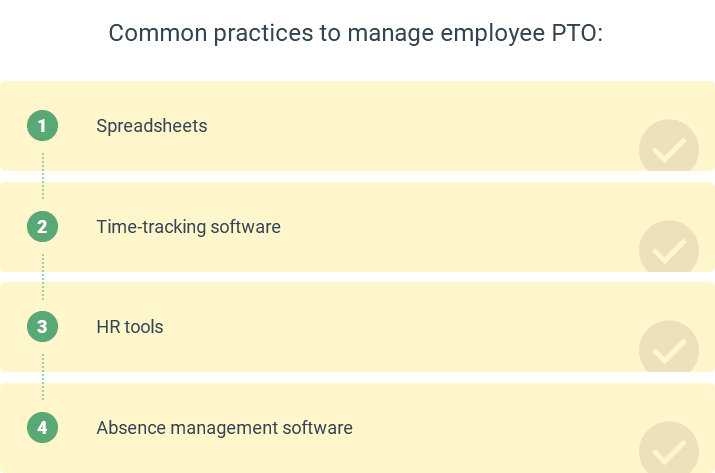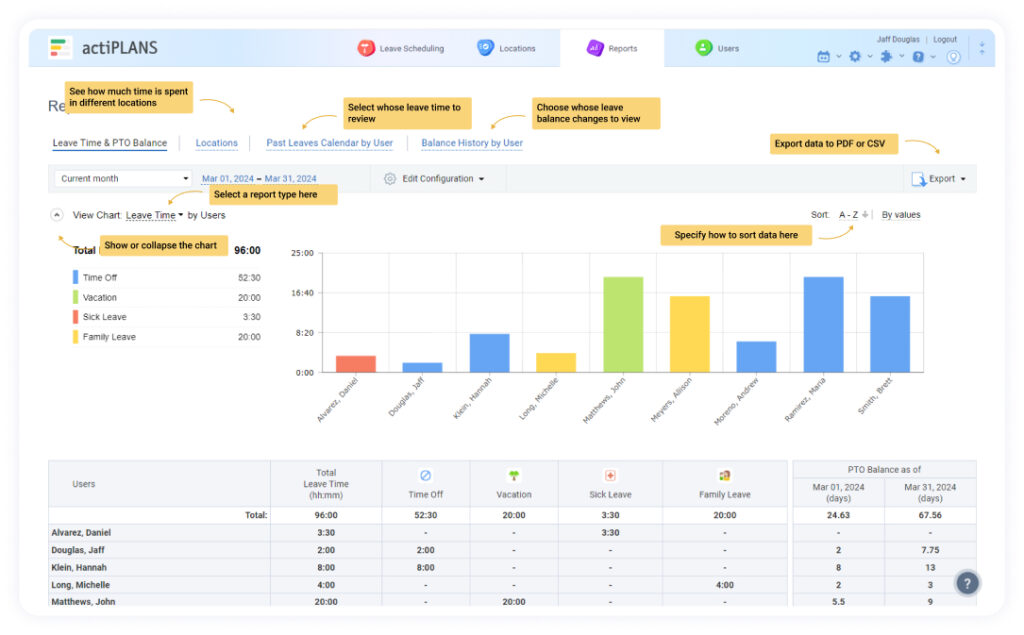Employees are not machines; they need time to rest and attend to personal matters. One of the most effective ways to support their well-being is a robust Paid Time Off (PTO) policy.
But what exactly is a PTO policy, and how can you create and implement one? Let’s dive into the details.
What Is a PTO Policy?
A Paid Time Off (PTO) policy represents a company’s formal approach to providing employees with paid leave for various reasons.
These can include vacation days, personal days, sick leave, and even time off for family emergencies or bereavement.
Unlike traditional vacation and sick leave policies that separate these categories, a PTO policy typically combines them into a single pool of days that employees can use at their discretion.
Why Does Your Company Need a Paid Time Off Policy?
A well-defined PTO policy enhances employee satisfaction and contributes to overall organizational success.
- Employee well-being. Regular breaks from work reduce burnout, stress, and fatigue, leading to happier and healthier employees.
- Enhanced productivity. A good PTO policy encourages employees to take necessary breaks, resulting in higher quality work and improved efficiency.
- Talent attraction and retention. Candidates often prioritize benefits like PTO when considering job offers. Furthermore, employees who feel valued and supported in their personal lives are less likely to seek employment elsewhere.
- Fostering a positive company culture. A thoughtful PTO policy reflects a company’s commitment to employees’ work-life balance. Such an environment can lead to higher morale and more robust team cohesion.
- Absenteeism reduction. When employees know they have paid time off available for personal matters or illness, they are less likely to resort to unscheduled absences.
- Healthy work-life balance. A well-defined PTO policy allows your staff to recharge and spend quality time with family and friends without feeling guilty about work obligations.
Creating a PTO Policy in 5 Steps
Your PTO policy is a legal document and should describe the guidelines it establishes in detail. Language should be clear and precise, with no room for vagueness or ambiguity.

As far as the actual contents of your policy go, make sure it covers the following key sections:1. Employee work hoursThe foundation of any PTO policy begins with a clear understanding of employee work hours. Clearly defining standard work hours helps set expectations for when employees are expected to be at work and when they can take time off.
Key points to include:
- Standard work hours: Specify the typical workweek (e.g., Monday through Friday, 9 AM to 5 PM) and any variations for part-time employees.
- Flexibility options: If applicable, outline any flexible work arrangements that may impact how PTO is utilized.
- Overtime considerations: Clarify how PTO interacts with overtime policies, ensuring employees understand how taking time off may affect their pay.
2. Available paid time off types
An effective PTO policy should clearly define the different types of leave available to employees. Thus, you will not only help employees understand their options but also ensure that all leave requests are handled consistently.
Common leave types to consider:
- Vacation Leave: Time off for personal enjoyment or relaxation.
- Sick Leave: Time off for health-related issues or medical appointments.
- Personal Leave: Time off for personal matters that do not fall under vacation or sick leave.
- Family Leave: Time off for family-related reasons, such as maternity or paternity leave.
- Bereavement Leave: Time off in the event of a death in the family.
The method by which employees accrue PTO is a crucial aspect of your policy. A clear and fair accrual system encourages employees to take time off while ensuring the company can manage its resources effectively.
Accrual methods to consider:
- Per pay period: Employees earn a set amount of PTO each pay period based on hours worked.
- Annual allocation: Employees receive a lump sum of PTO at the beginning of each year.
- Tenure-based accrual: Accrual rates increase based on the length of service, rewarding long-term employees with more generous time off.
If you’d like to go further and make your policy as comprehensive and detailed as possible, consider adding the following points:
- Tiered PTO accrual. Reward long-serving employees and incentivize junior staff by offering increased PTO based on years of service or job grade.
- Negative PTO balance. Determine whether employees can go into PTO debt. If allowed, establish options for repayment through overtime or unpaid leave.
- New employee waiting period. Specify any probationary period that must be completed before new hires are eligible for paid leave.
- Accrual or use-it-or-lose-it policies. Establish whether unused PTO can be carried over or forfeited after a designated period (e.g., calendar year).
Establishing a clear leave request procedure is vital for managing employee absences while ensuring operations run smoothly.
Essential elements of the procedure:
- Specify how far in advance employees must request time off (e.g., two weeks for vacation, as soon as possible for sick leave).
- Outline the preferred method for submitting requests (e.g., email, online form) and any necessary documentation (e.g., medical certificates for sick leave).
- Describe how requests will be reviewed and approved, including those responsible for making decisions.
5. Consequences of violations
Finally, addressing the consequences of violating the PTO policy is essential. This section protects the company and its employees by establishing accountability.
Key points to include:
- Clearly define what constitutes an unauthorized absence and the potential repercussions, such as disciplinary action.
- Specify any actions that would be considered misuse of PTO (e.g., falsifying reasons for taking leave) and the consequences of such actions.
- Encourage employees to report policy violations and outline the process.
Legal Considerations
Developing a PTO policy isn’t just about providing benefits; it also involves navigating a complex landscape of legal considerations.
So, be sure to study relevant federal laws such as:
- FMLA (Family and Medical Leave Act)
- ADA (Americans with Disabilities Act)
- USERRA (Uniformed Services Employment and Reemployment Rights Act)
- Title VII of the Civil Rights Act of 1964
Research your city and state laws regarding workers’ compensation. If you have remote employees or offices in multiple states, remember that you’ll need to comply with the laws of your employees’ location rather than where your head office is based.
It would also be a good idea to have a qualified attorney review your policy to ensure it doesn’t contain any problematic language or rules that could be easily misconstrued.
Unconventional PTO Policy Elements
Once you have the parts mentioned above locked down, your basic PTO policy is pretty much done and ready to go.
But aren’t you looking to create an employee-centric workplace where people feel valued, supported, and empowered to take the time they need to thrive both personally and professionally? Then read on, as you may come across some innovative ideas that may help you attract and retain top talent.
Did you know that Airbnb provides quarterly stipends for employees to travel and stay in Airbnb properties, immersing them in their core business?
A travel stipend is money given to an employee to help cover travel expenses. Travel stipends usually vary in size depending on the purpose of the trip.
For example, a travel stipend for a business trip may be higher than one for a personal vacation. Whatever the case, a travel stipend produces some immense advantages for businesses and employees alike, making the company more appealing to job seekers and boosting employee morale.
REI (an outdoor gear company) offers “Yay Days” where employees receive paid time off to engage in outdoor activities using REI equipment, promoting their active lifestyle brand.
Yay days are special days when people do things they love, like playing games, eating their favorite foods, and spending time with friends and family.
Like other cool time off perks, yay days are an excellent way for employers to show appreciation for their employees.
Besides, they can be an opportunity for networking and building relationships with co-workers. And let’s not forget, they’re a great way to increase morale and motivation in the workplace.
Among other interesting vacation trends are unlimited PTO, donation programs, mental health days, flexible accrual systems, sabbaticals, and other interesting instances of unusual PTO benefits to make you stand out.
PTO policy Sample
Creating a PTO policy can be daunting, especially if you’re not sure where to start. But don’t worry – we’ve got you covered. We made a sample PTO policy that you can use as a starting point for crafting your own.
Click here to check it out and download it for free!
Implementing PTO Policy
Aaaand… We are still not done! Crafting a comprehensive PTO policy is just the first step; the real challenge lies in executing it to maximize its benefits for both employees and the organization.
So, let’s see how you can make your efforts pay dividends in productivity, engagement, and overall workplace harmony.
Once a PTO policy has been established, it’s vital to communicate it to all employees. You have to not only share the details of the policy but also explain its purpose and benefits.
Tip: Ensure everyone is informed by multiple channels—such as employee handbooks, intranet sites, and team meetings.
Next, ensure that employees don’t feel reluctant to take time off, fearing it will reflect poorly on their work ethic or disrupt team dynamics.
Tip: Train managers to handle PTO requests and relocate workloads during absences, encouraging their teams to take time off.
And last but not least, don’t forget that the needs of your employees can change over time due to various factors, such as shifts in workforce demographics or changes in company culture. A good PTO policy should be flexible and adaptable to these changes.
Tip: Regularly review how the policy works for employees and the organization.
Modernizing PTO Tracking
To effectively manage employee absences, consider implementing a modern absence management solution. This choice can streamline your processes, reducing paperwork and improving efficiency.

Benefits of Third-Party Solutions
- Reduced paperwork: Automated processing eliminates the need for manual handling.
- Improved structure: Clear and consistent processes ensure transparency.
- Accurate data: Real-time tracking provides reliable information for decision-making.
- Automated PTO accruals: Streamlined calculations eliminate errors and save time.
Choosing the Right Solution
Before selecting a solution, consider the following:
- Integrated or dedicated: Evaluate existing HR systems or time tracking tools that offer absence management capabilities to avoid unnecessary costs.
- Cloud-Based or On-Premise: Determine if accessibility is paramount, as cloud-based solutions enable remote access.
- Flexibility: Choose software that supports multiple leave types, balances, and customized accruals for individual users or groups.
- Reporting capabilities: Ensure the solution provides essential reporting features to monitor employee PTO usage and plan effectively.
- Ease of use: Prioritize software that is intuitive and user-friendly for convenient request submissions and leave tracking.
Your choice could mean the difference between a paperwork-ridden slog and a simple stress-free procedure. And since this guide is aimed at making your life easier, we’ll just assume that you’re going with the latter approach.
Tools like actiPLANS help streamline the leave management process, ensuring a seamless experience for both employees and HR teams by offering features like:
- Leave request management
- Automated paid time off accrual
- Work scheduling
- Reports on leave time
- Mobile attendance tracker
- and more…

Our software makes managing employee time off quick and easy, so you can focus on what’s really important – running your business.
What are you waiting for? Get started today!




